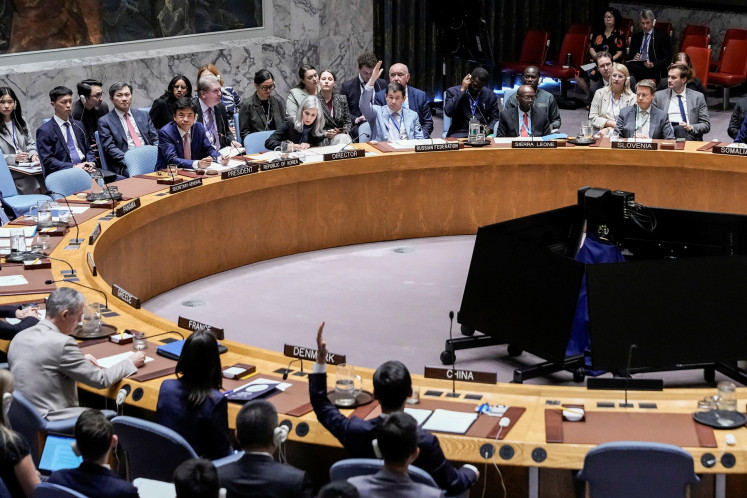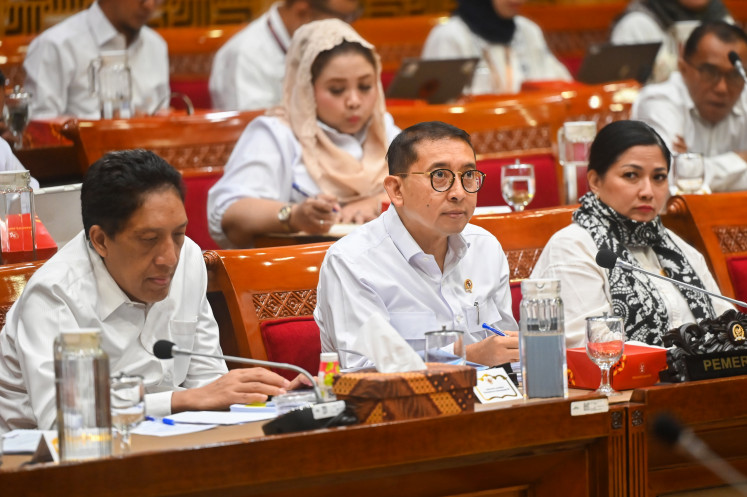Popular Reads
Top Results
Can't find what you're looking for?
View all search resultsPopular Reads
Top Results
Can't find what you're looking for?
View all search resultsChild labor: Work on dreams, not in fields!
After her baby Zoila, aka Zee, was born in July 2016, Sacha Stevenson of “How to act Indonesian” YouTube fame would feature her daughter in her videos
Change text size
Gift Premium Articles
to Anyone
A
fter her baby Zoila, aka Zee, was born in July 2016, Sacha Stevenson of “How to act Indonesian” YouTube fame would feature her daughter in her videos. When Zee was six months old, Sacha did a series whereby she got her to try different foods: papaya, avocado, yoghurt and even kimchi and durian. Really? Durian? Hmmm, okay, but kimchi? Really Sach!
Sacha would start by saying to Zee, “Your job today is to try […] (whatever foodstuff it was she made her try out)”. I teased her, what is this? Child labor? Well, that’s what happens when your mum is a YouTuber!
Most families do have a tradition of getting their kids to do household chores which is great. Age-appropriate obviously. Doing chores teaches them useful skills, cooperation, makes them feel they are making a contribution, and instills in them a sense of responsibility.
But children doing household chores and child labor, are totally different things. Today is World against Child Labor Day, commemorated yearly since 2002, initiated by the International Labor Organization (ILO) to raise awareness about this serious global issue.
The ILO defines child labor as “unsuitable work done by children younger than a specific age that interferes with their schooling, learning and rest, and is an obstacle to the physical, moral, emotional and psychological development of a child”.
The ILO’s latest report is titled “Children shouldn’t work in fields, but on dreams!”
There are a staggering 152 million child workers worldwide (could be more) working in every sector, dragged into “backbreaking labor, war, and sex trade […] that puts children at risk of ill health, injury or even death”.
Among these child workers, 88 million are boys, 64 million girls; 48 percent are aged between 5 and 11. Half of these child laborers are in Africa, 41 percent in Asia and the Pacific. Seven out of 10 work in agriculture which includes fishing, forestry, livestock herding and aquaculture.
Two-thirds of child laborers work in family farms and enterprises, so most likely they wouldn’t even be paid a salary.
Almost 73 million child laborers work in hazardous sectors (logging, construction, mining, prostitution, sex trafficking, slavery, debt bondage, etc.) and a quarter of them are children under 12 (19 million). Children are exploited as beggars, and as household servants, sometimes justified by the fact that they worked with their parent.
If you assumed that child labor was related to poverty, that would be correct but it’s only part of the truth. The international consulting firm Maplecroft Child Labor Index identified 10 countries with the highest incidences of child labor.
Six — Bangladesh, Chad, Ethiopia, Liberia, Myanmar and Somalia — are categorized by the United Nations as the least developed countries, that have the lowest socioeconomic development and Human Development Index ratings.
But four — Congo, India, Nigeria and Pakistan — are categorized as developing countries.
Nineteen percent of children exploited for labor live in low income countries, but 2 million live in high income countries. Yes, child labor exists in developed countries such as the United States and Europe as well, especially those affected by austerity measures such as Cyprus, Greece, Italy and Portugal.
What about conflict and disaster areas? The incidence of child labor is “77 percent higher than the global average; the incidence of hazardous work is 50 percent higher”, Maplecroft reports.
Climate change? Yup, that is also causing a spike in exploitative child labor. According to Ignacio Packer, secretary-general of Terres des Hommes, an environmental NGO, “Climate change is fuelling this surge in child exploitation — forcing kids to swap the safety of the classroom for the toxic gas of the gold mine.” Yikes! I’m sure this extends to more than just gold mines.
Not only are child workers deprived of an education, when they enter the labor market as adults, they find it more difficult to find jobs and when they do, they would most likely be in low paying jobs. It wouldn’t have something to do with the fact that they only have primary education would it?
Why does child labor persist? Cheap labor for one. Forced child labor is thought to generate around US$150 billion a year in illegal profits.
You may be shocked to find out that some of the products you often purchase are produced using slave and child labor. One undated report (https://content.wisestep.com/companies-use-child-labor/) said 28 companies apparently still use it, including leading chocolate and fashion companies, and others e.g. Apple, Philip Morris and Disney. Disney? How ironic!
I know of one Dutch company that produces slave — and child labor-free chocolate, Chocolonely that “tries to set the bar for other chocolate companies.” Besides being an ethical fair trade company, their chocolate tastes really good as well!
There are also cultural factors that contribute to child labor: filial and family duty, child marriage, lack of education, or the belief that earning money is more important than getting an education.
What is the situation in Indonesia? The Manpower Ministry says there are 1.6 million child workers whose pattern follows roughly the global pattern. In Indonesia, over 20 percent of child laborers work in palm oil and tobacco plantations.
The ministry, in collaboration with the ILO, has engaged in efforts to eliminate child labor by 2022. In 2017 they launched a “Roadmap Toward a Child Labor-Free Indonesia in 2022”. Hmm, ambitious!
According to the Coconuts Jakarta website, in 2013 the government announced a similar campaign to make Indonesia child-labor free in 2020. Sarcastically, Coconuts wrote, “Are they going to announce another campaign to make the country child-labor-free by 2025 in 2019?”
Well, the ILO also has a similar campaign to end child labor in 2025. We shouldn’t scoff at the government’s or the ILO’s good intentions, because the problem is an exceedingly complex one.
With so much uncertainty in current global politics and economics, not to mention the opportunism of parties that benefit from child labor, structural poverty, and deeply entrenched religious and cultural values, eliminating or even reducing child labor is a steep uphill struggle.
One thing we can do as consumers however, is not to purchase products produced and sold by companies who still use child labor.
It’s becoming increasingly hard to be an ethical consumer these days, but think of all those children who have lost their future due to being victims of child labor. By comparison, making informed consumer choices isn’t hard at all. What is certain, I will never look at a bar of chocolate the same way again!
______________
The writer is the author of Julia’s Jihad.










